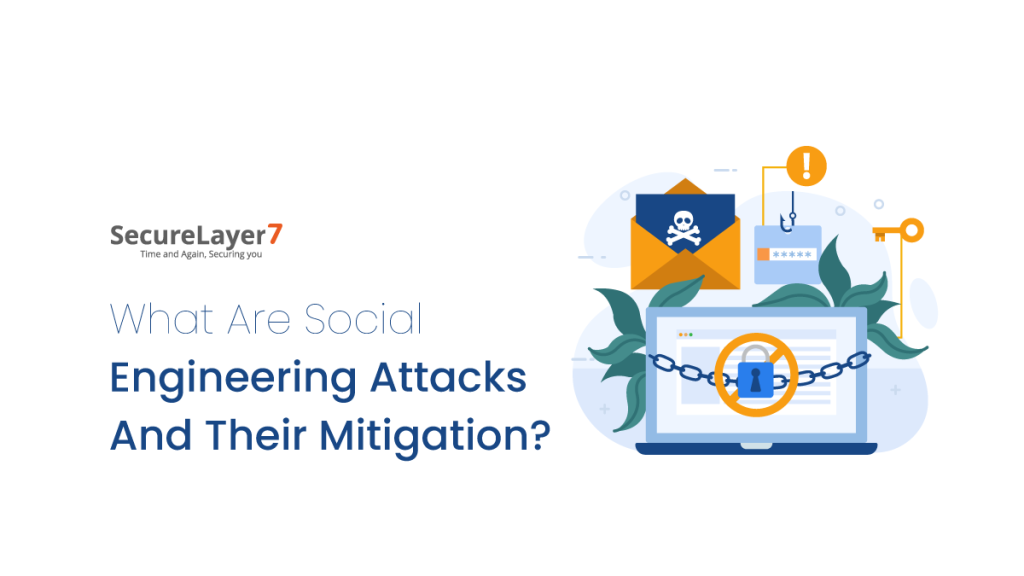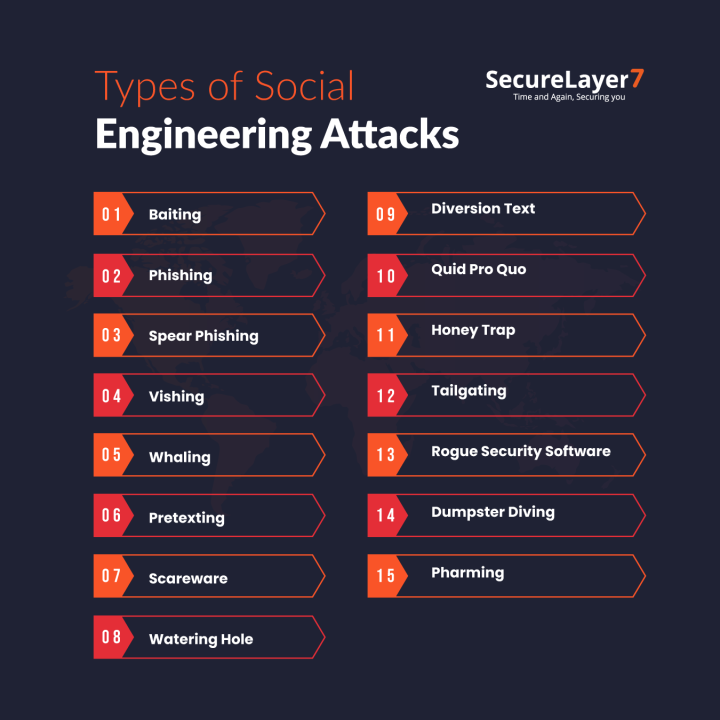
Cybersecurity in Healthcare, Challenges & Regulations
July 20, 2023
AppSec vs DevSecOps: Navigating the Security Landscape
August 1, 2023
In today’s interconnected world, where personal information and sensitive data are frequently exchanged online, the risk of falling victim to social engineering attacks has become a growing concern.
Social engineering is a deceptive technique used by cybercriminals to manipulate individuals into divulging confidential information, gaining unauthorized access, or performing actions that could compromise their own security or the security of an organization.
Unlike traditional hacking methods that rely on technical vulnerabilities, social engineering attacks exploit the vulnerabilities of human psychology.
These cunning tactics exploit our trust, curiosity, fear, or desire to help others, making it imperative for individuals and organizations to understand the various forms of social engineering and adopt effective mitigation strategies.
In this blog, we will delve into the world of social engineering attacks, exploring their different forms and shedding light on how to protect ourselves against them.
By enhancing our awareness and adopting proactive measures, we can minimize the risk of falling victim to these deceptive tactics and safeguard our personal and professional lives in the digital realm.
What is Social Engineering in cybersecurity?
Social engineering, a potent weapon in the arsenal of cybercriminals, involves exploiting the vulnerabilities of human psychology rather than relying solely on technical vulnerabilities.
It is a deceptive practice aimed at manipulating individuals into divulging sensitive information, granting unauthorized access, or carrying out actions that could compromise their own security or that of an organization.
In the realm of cybersecurity, social engineering acts as a means for attackers to bypass sophisticated security systems, as it preys on the weakest link in the chain: humans.
By exploiting our innate tendencies, such as trust, curiosity, and empathy, these attackers can deceive even the most cautious individuals and gain unauthorized access to valuable data or systems.
The success of a social engineering attack lies in the skilful manipulation of human behaviour. Attackers meticulously craft their schemes, employing various psychological tactics to deceive their targets.
They may pose as trustworthy individuals or organizations, create a sense of urgency or fear, or exploit human curiosity to entice victims into taking action that serves the attackers’ malicious purposes.
To comprehend the multifaceted nature of social engineering attacks, it is crucial to explore the different forms they can take.
From phishing emails and phone scams to impersonation, baiting, and pretexting, these techniques employ different strategies to exploit human vulnerability.
However, regardless of the specific method employed, the ultimate goal remains the same: gaining unauthorized access or sensitive information.
Types of Social Engineering Attacks
Social engineering attacks encompass a wide range of deceptive techniques employed by cybercriminals to exploit human psychology and manipulate individuals into compromising their security.
Understanding the various types of social engineering attacks is crucial for effectively mitigating the risks they pose.
Let’s explore some of the most common types of social engineering attacks:

1. Baiting
Attacks like baiting involve enticing individuals with the promise of something desirable, such as free software or a gift, in exchange for performing an action that compromises their security. These baits often come in the form of infected USB drives or links leading to malicious websites.
2. Phishing
One of the most prevalent form of social engineering is phising. Attackers impersonate trustworthy entities, such as banks or reputable organizations, and send deceptive emails or messages to trick victims into divulging sensitive information like passwords, credit card details, or login credentials.
3. Spear Phishing
A targeted form of phishing that focuses on specific individuals or organizationsSpear Phising takes place when attackers gather personal information about their targets to craft tailored messages, making them appear more legitimate and increasing the chances of success.
4. Vishing
Voice phishing also known as Vishing, involves attackers using phone calls to deceive individuals. They typically pose as representatives from trusted organizations, such as banks or government agencies, and manipulate victims into revealing confidential information or performing unauthorized actions.
5. Whaling
Whaling attacks specifically target high-profile individuals, such as executives or prominent figures. Attackers exploit their positions and authority to gain access to valuable information or financial resources.
6. Pretexting
One that Involves the creation of a fabricated scenario or pretext to manipulate individuals into sharing sensitive information is commonly known as pretexting, attackers here often pose as co-workers, IT technicians, or even law enforcement personnel to gain the trust of their victims.
7. Scareware
One such attack that play on individuals’ fears by presenting false alerts or warnings about malware infections on their devices is known as Scareware. The attackers then offer fake solutions or urge victims to download malicious software disguised as security tools.
8. Watering Hole
Watering hole attacks target specific websites or online platforms frequently visited by the intended victims. Attackers compromise these websites, injecting malicious code or links that infect the visitors’ devices.
9. Diversion Text
Diversion text attacks involve sending distracting text messages to victims to divert their attention while the attacker carries out unauthorized activities, such as making unauthorized transactions or gaining access to sensitive information.
10. Quid Pro Quo
Quid pro quo attacks involve offering a benefit or service to individuals in exchange for sensitive information. For example, an attacker may pose as an IT support technician offering assistance in exchange for login credentials.
11. Honey Trap
Honey trap attacks exploit human vulnerabilities, particularly in romantic or personal relationships. Attackers create fictitious online personas to establish relationships with individuals and extract sensitive information or gain unauthorized access.
12. Tailgating
It occurs when an unauthorized individual gains physical access to restricted areas by following an authorized person through controlled entry points without proper authorization.
13. Rogue Security Software
Rogue security software deceives users into downloading or purchasing fake security software that claims to protect their systems but instead introduces malware or exposes vulnerabilities.
14. Dumpster Diving
Dumpster diving involves attackers physically searching through trash or discarded materials to find valuable information, such as documents containing passwords, account numbers, or other sensitive data.
15. Pharming
Manipulating DNS (Domain Name System) settings or inject malicious code into compromised websites, redirecting users to fraudulent websites that mimic legitimate ones is known as Pharming. This tactic aims to deceive victims into entering their sensitive information, which is then captured by the attackers.
By familiarizing ourselves with these various types of social engineering attacks, we can better recognize and protect ourselves against the tactics employed by cybercriminals
How to Prevent Social Engineering Attacks
Preventing social engineering attacks requires a combination of vigilance, awareness, and proactive measures.
By adopting best practices and implementing robust security measures, individuals and organizations can significantly reduce the risk of falling victim to these deceptive tactics.
We have listed down some of the most effective ways to prevent social engineering attacks. Let these methods help you out in your of preveting social engineering attacks.

1. Education and Awareness
The first line of defense against social engineering attacks is education. Individuals should stay informed about the latest social engineering techniques and tactics employed by attackers.
Regular security awareness training programs can help individuals recognize the red flags, understand the risks, and develop a skeptical mindset.
2. Verify the Source
Whenever you receive a communication or request for sensitive information, it is crucial to verify the authenticity of the source. Contact the organization directly using verified contact details to confirm the legitimacy of the request. Avoid clicking on links or downloading attachments from suspicious or unsolicited emails, messages, or websites.
3. Strengthen Passwords
Use strong, unique passwords for all your online accounts. Avoid using easily guessable information such as birthdates or common words. Enable two-factor authentication whenever possible to add an extra layer of security.
4. Be Cautious of Sharing Personal Information
Be cautious when sharing personal or sensitive information online or over the phone. Only provide such information to trusted entities and avoid disclosing it on public platforms or in response to unsolicited requests.
5. Keep Softwares Updated
Regularly update your operating system, applications, and security software to ensure you have the latest security patches. Outdated software can contain vulnerabilities that attackers may exploit.
6. Spam Filters
Use spam filters on your email accounts to help detect and filter out suspicious or malicious emails. These filters can help reduce the likelihood of falling for phishing or spear phishing attacks.
7. Use Secure Wi-Fi Networks
When accessing the internet in public places, use secure and trusted Wi-Fi networks. Avoid connecting to unsecured or unfamiliar networks, as they can be compromised and used for eavesdropping or data interception.
8. Implement Security Policies
Organizations should establish and enforce comprehensive security policies that address social engineering risks. These policies should include guidelines for information sharing, password management, and reporting suspicious activities.
9. Regularly Back Up Data
Regularly back up your important data to secure and encrypted external storage or cloud services. In the event of a social engineering attack, having backups can help restore your data and minimize the impact of an incident.
10. Stay Updated on Security Threats
Stay informed about the latest security threats and trends in social engineering. Subscribe to security newsletters, follow reputable cybersecurity blogs, and participate in relevant forums to stay updated on emerging risks and mitigation techniques.
Strengthen Your Defense Against Social Engineering Attacks with SecureLayer7!
Take the first step towards safeguarding your sensitive information, customer data, and financial assets by partnering with our team of skilled professionals.
Our comprehensive assessment will identify weak points in your organization’s human security layer, empowering you to fortify your defences and stay one step ahead of cybercriminals.
Don’t wait until it’s too late. Contact SecureLayer7 today and let us help you build a resilient defence against social engineering attacks. Together, we can ensure your business remains secure and your valuable assets are safe from harm.
Remember, in the ever-evolving world of cybersecurity, prevention is the key to protection. Take action now with SecureLayer7.


